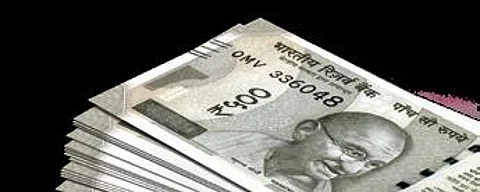

A significant increase in trade and commerce, detailed information on duties and cess, and well-maintained overseas trade were all made possible under the Cholas through their precise detailing of weights and measurement units. Chanakya in his Artha Sastra emphasised on accounting trade activities with a fixed unit of measurement alongside a monetary denomination. The value of money was fixed on the measure of metal that goes into making the coins. This system of standardisation of measurement units against an assigned value for money was fine-tuned during the imperial Chola rule.
The earliest reference to weight measurement comes from epigraphic records of Parantaka I, where kalanju and manjadi are the standard units of weight measure. In theory, a manjadi in weight equals 72 normal sized paddy grains. Coins casted in copper or other alloys with minimum traceable quantity of precious metals like gold have been minted to weigh close to the standard weight.
During the 10th century CE, pon was used as an equivalent to kalanju in full weight as gold. This unit is referred to as madurantaka-devan madai. It yielded the same interest as kalanju and was also used as a standard unit for testing the quality of gold. Another popular unit used for mentioning monetary value is kasu. There are references starting from the times of Aditya II (10th century CE) equating twenty kasu-s to ten kalanju-s. Rajaraja I issued what was called rajarajan kasu which was equal to half of madai. Different issues are classified in epigraphy based on the prefixes like rajarajan kasu, rajendhra cholan madai, etc.
Coins minted in fine gold were in use. From whatever has been discovered so far, gold coins were thin disc shaped ones that carried the insignia in the centre with title of the king and the regnal year punched around the perimeter. The other side is left blank. Titles like gangai-konda-cholan (Rajendra I), malai-nadu-konda-cholan ( Rajadhiraja I) are used to denote the period of issuing the coin.
Parantaka I’s invasion of the Pandya country and Sri Lanka had the scope for absorbing numismatic designs from the coins of the erstwhile Sri Lankan kingdom. These coins had an amorphic standing image on one side and the other side had an image seated. There are other coins with the traditional seated tiger, fish and bow emblem adopted by the Cholas that were minted and in circulation. It is interesting to note that Sri Lankan standards were chosen to be used by the imperial Cholas much before the times of Rajaraja I.
It was post Rajaraja I’s time, with the expansion of the empire through planned conquests, that the currency system of the Cholas spread across their territory. It is even more interesting to note that Rajaraja I’s coins were discovered in regions beyond his territory. The socio-political changes that happened from the times of Kulothunga I had its impact in the issuing of coins too. Several coins carrying the name of feudatories and their titles started finding a mention in Chola inscriptions. This can be clearly viewed as a sign of the downfall of economic control that the imperial Chola had on their feudatories. Names like jaya-mada, uththama-gandan-mada, chamara-mada, biruda-mada, bhujabala-mada found mentions in their respective regional Chola inscriptions.
Gold and silver ratio used in minting these coins is derived from a Kulothunga I period inscription. Roughly 433 kalanju-s of silver formed the equivalent of 100 kasu-s. In that case a kalanju of gold was equal to 8.66 kalanju-s of silver.
Much later, after the times of Kulothunga III, the alloy had more copper, reducing the value drastically. While a few pazhankaasu (old coins) were enough to endow the burning of a lamp, 9,000 current kasu-s were required to endow a perpetual one in the temple. An inscription from the 20th regnal year of Rajendra III states that a kalanju of gold was equal to 411 7/13 kasu-s.
Thus, an attempt to standardise currency units has started from Parantaka I’s time, with his victory over Sri Lanka serving as inspiration. However, the existence of a currency system even before that cannot be denied too. But it was during the expansion of the empire under the kingship of Rajaraja I that coins with names, royal insignia and titles came out in abundance. Till date, Chola numismatic studies are split into pre- and post-Rajaraja times. His coins, found in faraway territories and those released in Sri Lanka, find a special mention. Similar to the downfall in its glory, the mighty Chola Empire slowly started losing their economic control during the last phase of their rule. The feudatories released independent coins with their names and titles on it. After the downfall, the large availability of coins from the Chola mint continued to be used in local transactions. The imagery that Chola currencies had is seen from the fact that the mould design continued to be used centuries after their rule came to a close too.
(madhu.kalai0324@gmail.com)